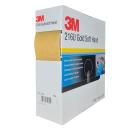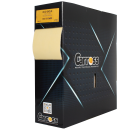Bodywork foam abrasive rolls

Masking foam tape for cars and motorbikes
︾
Masking foam tape for sanding car bodies
Carross offers you a whole range of sanding rollers for hand sanding car and motorbike bodywork. On its online shop, Carross offers you 4CR brand rollers for all your Paint work. These rollers will enable you to sand putties or primers on all flat or curved surfaces. With these pre-cut sanding sheets, you can achieve precision sanding. This product is available in a range of grits from 180 to 800. Carross offers other abrasives in its online shop. As well as Velcro sanding belts, ideal for sanding your car or motorbike bodywork. Our abrasive rollers can be adapted to any sanding need, whatever the type of material (steel, plastic, metal, etc.). Carefully selected by Carross, the sanding rollers available are among the best on the market and have excellent sanding capacity. They are also highly resistant to soiling. If you still have questions about our sanding belts, detailed descriptions follow below. If you have any technical questions about a specific bodywork sanding job, or any questions about our products, find out more about our sanding belts below!
Carross sanding rollers
Whatever bodywork work you need to do, Carross has the perfect sanding roller for your workshop. Our abrasive rollers are made for intensive use by professionals and are designed to treat all the materials that make up a body: aluminium, primer, copper, metal... You can also use our abrasive rollers on less conventional materials: wood, composites, etc. What's more, the abrasive rollers we offer fit all your Sanding machines. If you still have any doubts, our sales team is on hand to help you choose the best abrasive product.
Which abrasive to choose?
Sanding is an essential part of getting the best possible bodywork. To achieve this, you need to choose the right sanding roller, and not all rollers are of the same quality! That's why Carross has selected the very best in sanding products, from sanding sheets and Abrasive discs, which you'll find at this address, to our entire selection of sanding equipment.The choice of sanding roller depends on the work you're going to do on the bodywork. For finishing work, a fine grit is ideal (between 150 and 220), but for more general work, a coarse grit is preferable (from P80 upwards). Carross sanding rollers come in a range of grits (from 240 to 800). If you're looking for a quality abrasive roller, you can opt for the 3M abrasive roller. 3M is renowned for its excellent quality products, and 3M abrasive rollers are no exception. The 216U model has been specially designed for versatile bodywork work. This product is perfect for complementing mechanical Sanding and for treating irregular surfaces. What's more, the aluminium oxide composition of the sanding roller means you can sand any surface without difficulty. The abrasive roller has excellent anti-fouling properties.
Abrasive roller or belt
If you're looking for other types of abrasive for your bodywork, you'll find everything you need at Intercarross, for example. The SR70 abrasive belt is versatile: it can treat or touch up many types of material and is well suited to any bodywork job. S70 abrasive belts have a wide choice of different grits: you can choose from P80 to P600. Another great advantage of this sanding belt is that it tears easily. What's more, our sanding belts are high quality: the SR 70 clogs up slowly. Your bodywork will look better than ever with the products and sanding belts available from the Carross online shop.
Sanding belts: remember to protect yourself
Abrasive belts are like abrasive paper: you have to use them with care. In general: anything to do with bodywork and car paint should be handled with care. You'll find a wide range of equipment products to protect you from cuts or dust that could get into your body. All this protective equipment is available from the Carross online shop.
Using the foam abrasive roller for bodywork :
Foam abrasive rollers are versatile tools used for a variety of sanding, surface preparation, and finishing applications. Here's a step-by-step guide on how to use foam abrasive rollers:
Materials required:
Masking foam tape:
Choose the type of roller according to the material to be sanded and the specific application.
Support or handle:
Some foam abrasive rollers are designed to be attached to a stand or handle for convenient use.
Personal protective equipment (PPE):
Wear goggles and, if necessary, gloves to protect against abrasive particles.
Steps for using Masking foam tape abrasive rollers:
Preparing the surface:
Make sure the surface to be sanded is clean and free of any residue. If necessary, clean the surface before starting.
Choosing the grain of the sanding roller:
Select the appropriate grit according to the stage of the project. Coarser grits are used for initial Sanding, while finer grits are suitable for finishing.
Attaching the roller to the backing or handle:
Some foam abrasive rollers are designed to be mounted on brackets or handles. Make sure the roller is securely fastened for optimum control.
Regular movements:
Use back-and-forth or circular movements, applying moderate pressure to the surface. Keep the roller in constant motion to avoid marks forming.
Adapt to contours:
The flexibility of the foam allows the roller to adapt to the contours of the surface, making it easier to sand curved or irregular areas.
Regular cleaning:
Clean the abrasive roller regularly by rubbing gently against a clean surface to remove abrasive particles and residues.
Check the surface:
After Sanding, check the surface to ensure that you have achieved the desired level of smoothness. If necessary, you can switch to finer abrasive roller grains for a smoother finish.
Final cleaning :
Remove all dust and residue generated during Sanding. This is particularly important before applying any coating, paint or finish.
Change roller if necessary:
If the foam abrasive roller becomes worn or ineffective, replace it with a new one to ensure consistent results.
Foam abrasive rollers are useful for precision sanding jobs, especially on curved or delicate surfaces. By following these steps, you can effectively use foam abrasive rollers to prepare surfaces before painting, varnishing or other finishing work.
Your questions about using the Masking foam tape :
Users involved in car bodywork projects frequently ask crucial questions about the use of foam abrasive rollers, looking to optimise their technique to achieve impeccable results. Here's a guide to recurring questions from users, with informative answers to guide them in their use of the foam abrasive roller:
1. How do I choose the right foam roller for bodywork?
Choose a foam roller suitable for bodywork, with the right density and flexibility. Coarser grits are generally used for initial Sanding, while finer grits are suitable for finishing.
2. Can I use the same roller for different stages of the surface preparation process?
Yes, but it is recommended that you change rollers depending on the stage. Use a coarser grit for initial sanding and a finer grit for finishing.
3. How can I avoid circular marks when sanding with a foam sanding roller?
Use regular back-and-forth or circular movements, applying moderate pressure. Avoid staying in one place for too long to prevent marks forming.
4. How often should I clean the foam roller while sanding?
Clean the roller regularly by rubbing gently against a clean surface to remove abrasive particles and residues. A clean roller ensures optimum performance.
5. Can I use the foam sanding roller on plastic or Fiberglass surfaces?
Yes, but choose a suitable roller with a fine grain to avoid damaging the surface. Some foam rollers are specially designed to be gentle on delicate materials.
6. Can the foam abrasive roller be reused?
Yes, as long as it remains in good condition. However, replace it as soon as it shows signs of wear or inefficiency to ensure consistent results.
7. How do I adapt the Masking foam tape to the contours of the bodywork?
The flexibility of the foam allows the roller to adapt to the contours of the bodywork, making it easier to Sanding curved or irregular areas.
8. Can I use water when sanding with a foam sanding roller?
Yes, some foam rollers are designed to be used with water. This can reduce the heat generated and minimise dust during Sanding.
By understanding these answers to frequently asked questions, users can effectively exploit the potential of foam abrasive rollers for successful bodywork jobs. Selecting the right grit, keeping the roller clean, and following best Sanding practices will all contribute to a quality end result.

